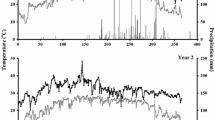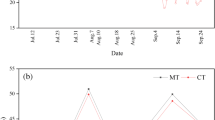Abstract
Conventional blanket application of nitrogen (N) fertilizer results in more loss of N from soil system and emission of nitrous oxide, a greenhouse gas (GHG). The leaf color chart (LCC) can be used for real-time N management and synchronizing N application with crop demand to reduce GHG emission. A 1-year study was carried out to evaluate the impact of conventional and LCC-based urea application on emission of nitrous oxide, methane, and carbon dioxide in a rice–wheat system of the Indo-Gangetic Plains of India. Treatments consisted of LCC scores of ≤4 and 5 for rice and wheat and were compared with conventional fixed-time N splitting schedule. The LCC-based urea application reduced nitrous oxide emission in rice and wheat. Application of 120 kg N per hectare at LCC ≤ 4 decreased nitrous oxide emission by 16% and methane by 11% over the conventional split application of urea in rice. However, application of N at LCC ≤ 5 increased nitrous oxide emission by 11% over the LCC ≤ 4 treatment in rice. Wheat reduction of nitrous oxide at LCC ≤ 4 was 18% as compared to the conventional method. Application of LCC-based N did not affect carbon dioxide emission from soil in rice and wheat. The global warming potential (GWP) were 12,395 and 13,692 kg CO2 ha−1 in LCC ≤ 4 and conventional urea application, respectively. Total carbon fixed in conventional urea application in rice–wheat system was 4.89 Mg C ha−1 and it increased to 5.54 Mg C ha−1 in LCC-based urea application (LCC ≤ 4). The study showed that LCC-based urea application can reduce GWP of a rice–wheat system by 10.5%.




Similar content being viewed by others
References
Abdulrachman, S., Gines, H. C., Nagarajan, R., Satawathananont, S., Son, T. T., Tan, P. S., et al. (2002). Variation in the performance of site-specific nutrient management among different environments with irrigated rice in Asia. Better Crops International, 16, 18–23.
Alam, M. M., Buresh, R. J., Ladha, J. K., & Khan, A. H. (2004). Site-specific nutrient management (SSNM) for rice: recommendations and user guidelines. Gazipur: Bangladesh Rice Research Institute.
Arah, J. R. M., & Smith, K. A. (1989). Steady state denitrification in aggregated soils: a mathematical model. Journal of Soil Science, 40, 139–149.
Balasubramanian, V., Ladha, J. K., Gupta, R. K., Naresh, R. K., Mehla, R. S., Bijay-Singh, et al. (2003). In J. K. Ladha et al. (Eds.), Improving the productivity and sustainability of rice–wheat systems: Issues and impact (pp. 115–118). Madison: ASA. ASA Spec Publ 65.
Banerjee, B., Pathak, H., & Aggarwal, P. K. (2002). Effects of dicyandiamide, farmyard manure and irrigation on ammonia volatilization from an alluvial soil in rice (Oryza sativa L.)-wheat (Triticum aestivum L.) cropping system. Biology and Fertility of Soils, 36, 207–214.
Bijay-Singh, & Yadvinder-Singh. (2003). Efficient nitrogen management in rice-wheat system in the Indo-Gangetic plains. In Yadvinder-Singh, Bijay-Singh, V. K. Nayyar, & J. Singh (Eds.), Nutrient management for sustainable rice–wheat cropping system. National Agricultural Technology Project (pp. 99–114). New Delhi: Indian Council of Agricultural Research.
Bijay-Singh, Yadvinder-Singh, Ladha, J. K., Bronson, K. F., Balasubramanian, V., Singh, J., et al. (2002). Chlorophyll meter and leaf color chart-based nitrogen management for rice and wheat in northwestern India. Agronomy Journal, 94, 821–829.
Dick, R. P. (1992). A review: long-term effects of agricultural systems on soil biochemical and microbial parameters. Agriculture, Ecosystems and Environment, 40, 25–36.
Dobermann, A., Witt, C., Dawe, D., Abdulrachman, S., Gines, H. C., Nagarajan, R., et al. (2002). Site-specific nutrient management for intensive rice cropping systems in Asia. Field Crops Research, 74, 37–66.
Grace, P. R., Harrington, L., Jain, M. C., & Robertson, G. P. (2003). Long term sustainability of tropical and subtropical rice-wheat system: an environmental perspective. In J. K. Ladha et al. (Eds.), Improving the productivity and sustainability of rice-wheat systems: Issues and Impacts (pp. 27–41). Madison: ASA. ASA Spec Publ 65.
IPCC. (2007). The physical science basis. In S. Solomon, D. Qin, M. Manning, Z. Chen, M. Marquis, K. B. Averyt, M. Tignor, & H. L. Miller (Eds.), Climate change 2007: Contribution of working group I to the fourth assessment report of the intergovernmental panel on climate change. Cambridge: Cambridge University Press.
IRRI (International Rice Research Institute). (2005). Accelerating technology adoption to improve rural livelihoods in the rainfed Eastern Gangetic Plains. IRRI technical report, ref. DPPC2002-27. Los Baños: IRRI.
Jain, M. C., Kumar, S., Wassmann, R., Mitra, S., Singh, S. D., Singh, J. P., et al. (2000). Methane emissions from irrigated rice fields in Northern India (New Delhi). Nutrient Cycling in Agroecosystems, 58, 75–83.
Kotsyurbenko, O. R., Chin, K. J., Glagolev, M. V., Stubner, S., Simankova, M. V., Nozhevnikova, A. N., et al. (2004). Acetoclastic and hydrogenotrophic methane production and methanogenic populations in an acidic West-Siberian peat bog. Environmental Microbiology, 6, 1159–1173.
Ladha, J. K., Pathak, H., Krupnik, T. J., Six, J., & van Kessel, C. (2005). Efficiency of fertilizer nitrogen in cereal production: retrospects and prospects. Advances in Agronomy, 87, 85–176.
Lessard, R., Rochette, P., Topp, E., Pattey, E., Desjardins, R. L., & Beaumont, G. (1994). Methane and carbon dioxide fluxes from poorly drained adjacent cultivated and forest sites. Canadian Journal of Soil Science, 74, 139–148.
Majumdar, D., Kumar, S., Pathak, H., Jain, M. C., & Kumar, U. (2000). Reducing nitrous oxide emission from rice field with nitrification inhibitors. Agriculture, Ecosystems and Environment, 81, 163–169.
Page, A. L., Miller, R. H., & Keeney, D. R. (1982). Methods of soil analysis. Part 2, chemical and microbiological properties (2nd ed., p. 1159). Madison: ASA-SSSA.
Pathak, H. (2010). Mitigating greenhouse gas and nitrogen loss with improved fertilizer management in rice: quantification and economic assessment. Nutrient Cycling in Agroecosystems. doi:10.1007/s10705-010-9350-z.
Pathak, H., Bhatia, A., Prasad, S., Singh, S., Kumar, S., Jain, M. C., et al. (2002). Emission of nitrous oxide from soil in rice wheat systems of Indo-Gangetic plains of India. Environtmental Monitoring and Assessment, 77, 163–178.
Peng, S., Garcia, F. V., Laza, R. C., Sanico, A. L., Visperas, R. M., & Cassman, K. G. (1996). Increased N-use efficiency using a chlorophyll meter on high-yielding irrigated rice. Field Crops Research, 47, 243–252.
Pham, S. T., Tuyen, T. Q., Huan, T. T. N., Khuong, T. Q., Diep, L. N., Dung, H. T., et al. (2000). Site-specific nutrient management in intensive nutrient rice ecosystems: a case study in Omon district, Cantho province. Omon Rice, 8, 64–74.
Shukla, A. K., Ladha, J. K., Singh, V. K., Dwivedi, B. S., Balasubramanian, V., Gupta, R. J., et al. (2004). Calibrating the leaf color chart for nitrogen management in different genotypes of rice and wheat in a systems perspective. Agronomy Journal, 96, 1606–1621.
Singh, J. S., Singh, S., Raghubanshi, A. S., Singh, S., & Kashyap, A. K. (1996). Methane flux from rice/wheat agro-ecosystem as affected by crop phenology, fertilization and water level. Plant and Soil, 183, 323–327.
Singh, J. S., Raghubanshi, A. S., Reddy, V. S., Singh, S., & Kashyap, A. K. (1998). Methane flux from irrigated paddy and dryland rice fields, and from seasonally dry tropical forest and savanna soils of India. Soil Biology and Biochemistry, 30, 135–139.
Sriegel, R. G., McConnaughey, T. A., Thorsteson, D. C., Weeks, E. P., & Woodward, J. C. (1992). Consumption of atmospheric methane by desert soils. Nature, 357, 145–147.
Varinderpal-Singh, B.-S., Yadvinder-Singh, T. H. S., & Gupta, R. K. (2010). Need based nitrogen management using the chlorophyll meter and leaf colour chart in rice and wheat in South Asia: a review. Nutrient Cycling in Agroecosystems, 88, 361–380.
Wang, G. H., Dobermann, A., Witt, C., Sun, Q. Z., & Fu, R. X. (2001). Performance of site-specific nutrient management for irrigated rice in southeast China. Agronomy Journal, 93, 869–878.
Wang, G., Zhanga, Q. C., Witt, C., & Buresh, R. J. (2007). Opportunities for yield increases and environmental benefits through site-specific nutrient management in rice systems of Zhejiang province China. Agricultural Systems, 94, 801–808.
Author information
Authors and Affiliations
Corresponding author
Rights and permissions
About this article
Cite this article
Bhatia, A., Pathak, H., Jain, N. et al. Greenhouse gas mitigation in rice–wheat system with leaf color chart-based urea application. Environ Monit Assess 184, 3095–3107 (2012). https://doi.org/10.1007/s10661-011-2174-8
Received:
Accepted:
Published:
Issue Date:
DOI: https://doi.org/10.1007/s10661-011-2174-8




